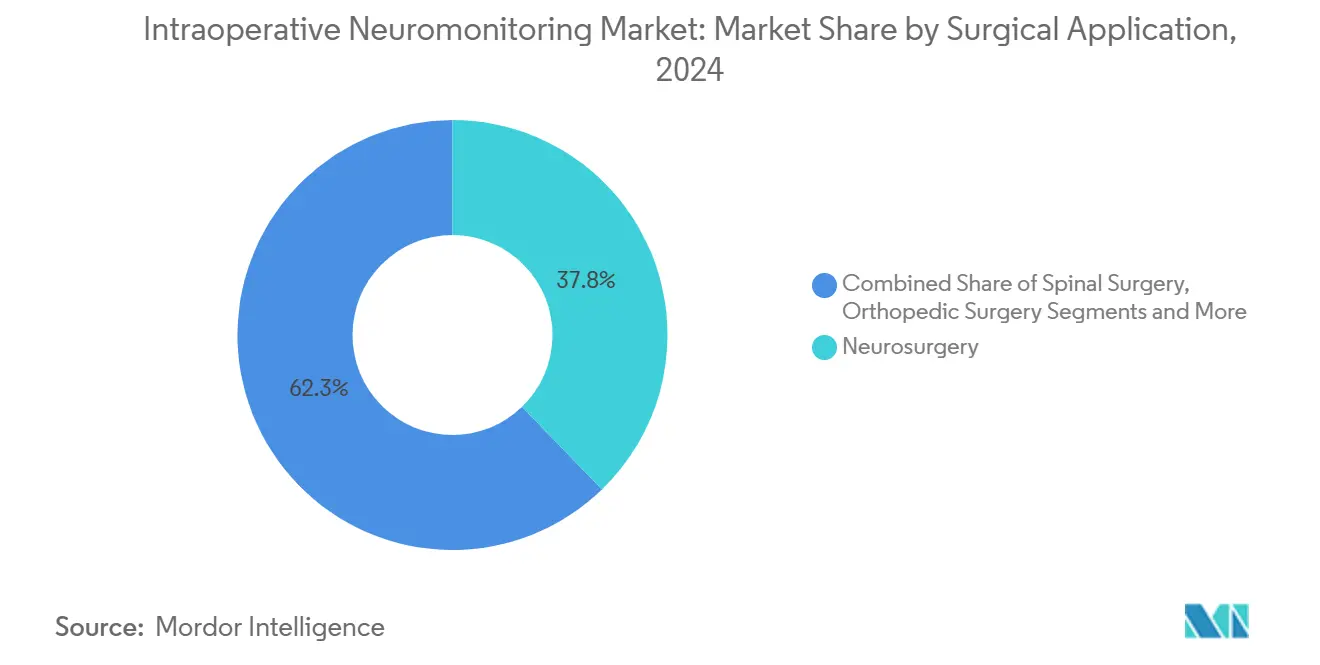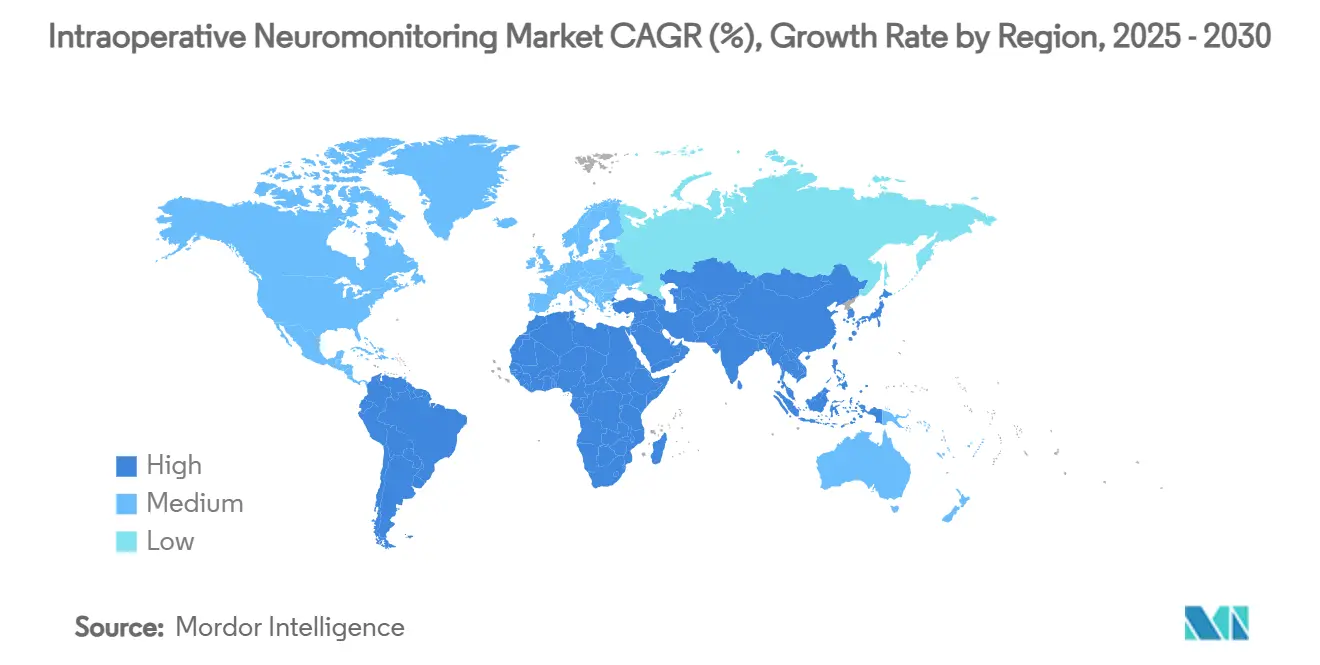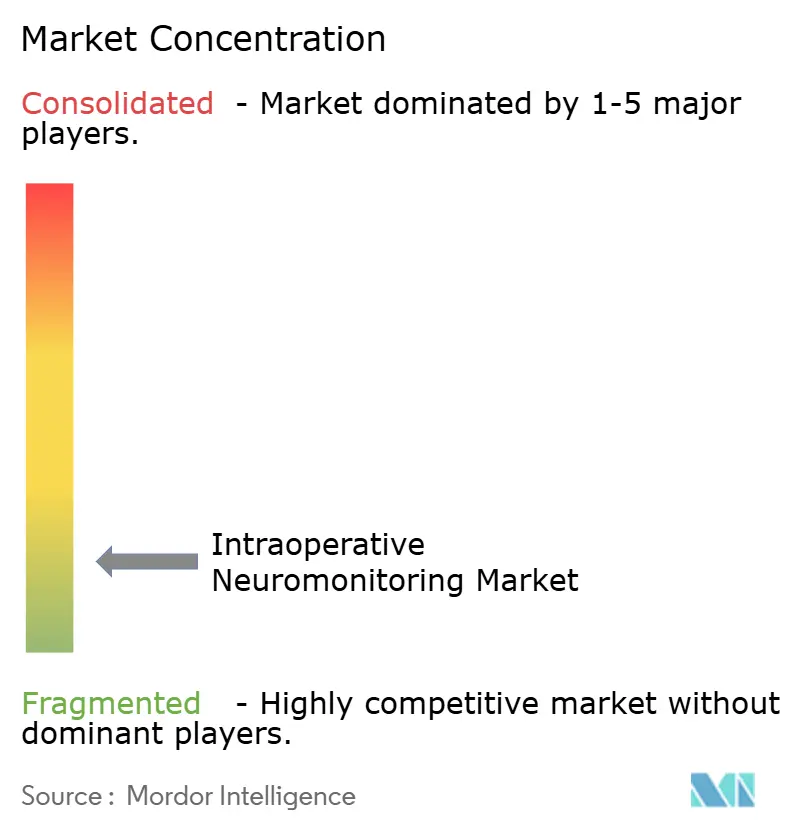Intraoperative Neuromonitoring Market Size and Share

Intraoperative Neuromonitoring Market Analysis by Mordor Intelligence
The intraoperative neuromonitoring market stands at USD 3.65 billion in 2025 and is forecast to reach USD 4.77 billion by 2030, advancing at a 5.46% CAGR. Growing surgical complexity, mandatory risk-mitigation rules, and the pairing of artificial intelligence with multimodal monitoring are lifting demand across surgical specialties. Hospitals and ambulatory surgical centers increasingly rely on closed-loop platforms that adjust stimulation 50 times each second, cutting liability exposure while sharpening surgical accuracy. Outsourcing momentum continues because certified neurophysiologists remain in short supply, allowing specialized service firms to scale rapidly. Meanwhile, mergers such as Nihon Kohden’s 71.4% stake in Ad-Tech Medical and the 2024 Globus Medical–NuVasive tie-up signal a shift toward vertically integrated device-plus-service ecosystems that deepen competitive moats.
Key Report Takeaways
- By product & service, the system held 45.97% of the intraoperative neuromonitoring market share in 2024, while service are projected to rise at a 6.26% CAGR to 2030.
- By source type, insourced monitoring accounted for 55.08% of the intraoperative neuromonitoring market size in 2024, yet outsourced providers are set to expand at a 6.36% CAGR through 2030.
- By monitoring modality, somatosensory evoked potentials led with 36.42% revenue share in 2024; auditory and motor evoked potentials (MEPs) are poised for the fastest 6.65% CAGR to 2030.
- By surgical application, neurosurgery captured 37.75% of the intraoperative neuromonitoring market share in 2024, while spinal surgery is on course for a 6.28% CAGR to 2030.
- By end-user, hospitals contributed 81.98% of the intraoperative neuromonitoring market size in 2024, even as ambulatory surgical centers advance at a 7.41% CAGR through 2030.
- By geography, North America led with 44.16% contribution in 2024, and Asia-Pacific is forecast to grow the quickest at an 7.41% CAGR through 2030.
Global Intraoperative Neuromonitoring Market Trends and Insights
Drivers Impact Analysis
| Driver | (~) % Impact on CAGR Forecast | Geographic Relevance | Impact Timeline |
|---|---|---|---|
| Rising chronic disease burden & surgical volumes | +1.2% | North America, Europe, global spill-over | Medium term (2-4 years) |
| Mandatory risk-mitigation policies | +0.8% | North America, European Union, APAC uptake | Short term (≤ 2 years) |
| Rapid technology upgrades (multimodal, AI-enabled) | +1.5% | North America, APAC, global diffusion | Medium term (2-4 years) |
| Growth of third-party IONM service providers | +0.9% | North America core, global expansion | Long term (≥ 4 years) |
| Outpatient & ASC shift toward portable solutions | +1.1% | North America, Europe, emerging APAC | Medium term (2-4 years) |
| Convergence with robotic & AR surgery platforms | +0.7% | APAC, North America, selective EU | Long term (≥ 4 years) |
| Source: Mordor Intelligence | |||
Rising Chronic Disease Burden & Surgical Volumes
The aging population is boosting procedure counts for spine, brain, and vascular interventions, each needing precise neural pathway protection. Countries such as Japan use AI-driven platforms to offset workforce gaps while guaranteeing surgical safety. Minimally invasive methods intensify monitoring needs because smaller anatomical windows raise injury risk. Endoscopic spine approaches illustrate this pattern, demanding real-time sensory and motor feedback to avert iatrogenic harm. Higher volume and complexity combine to multiply demand for adaptive monitoring able to calibrate signals to each patient.
Mandatory Risk-Mitigation Policies By Hospitals & Insurers
Value-based care reimburses according to outcomes, pushing hospitals to document intraoperative neuromonitoring for high-risk cases. Insurers increasingly deny payment if evidence of monitoring is absent during complex spine or cranial work, reflecting the high cost of postoperative neurological deficits. Electronic health records now capture monitoring data in real time, creating defensible quality dashboards that shape payer contracts. Standardized protocols lower outcome variability and anchor liability frameworks.
Rapid Technology Upgrades (Multimodal, AI-Enabled Systems)
Closed-loop systems automatically tune stimulation by sensing neural responses dozens of times a second, cutting false-alarm rates while improving efficacy. Kirigami-inspired flexible 3D probes gather high-density cortical signals without tissue trauma, bringing next-generation feedback into hybrid surgical suites.[1]Anna Tipping, “Scientists Create Novel 3D Neuroprobes Based on Kirigami-Inspired Folds,” Phys.org, phys.org Combined sensory, motor, and electromyography readings now form clinical best practice, with machine-learning models predicting complications before they surface clinically.[2]Rajesh Kumar, John Smith, “Intraoperative Neurophysiological Monitoring in Neurosurgery,” PMC, pmc.ncbi.nlm.nih.gov
Growth Of Third-Party IONM Service Providers
Hospitals turn to external experts to sidestep staffing hurdles and upfront equipment costs. Assure Holdings’ USD 4.5 million asset sale to MPOWERHealth shows scale-driven consolidation that widens national coverage footprints. Outsourced firms employ centralized interpretation hubs that allow one certified neurophysiologist to supervise multiple operating rooms, offering cost-effective compliance with accreditation standards.
Restraints Impact Analysis
| Restraint | (~) % Impact on CAGR Forecast | Geographic Relevance | Impact Timeline |
|---|---|---|---|
| High capital & service cost of IONM systems | -0.7% | Emerging markets, selective developed | Short term (≤ 2 years) |
| Shortage of certified neurophysiologists | -0.5% | Global, acute outside metro hubs | Medium term (2-4 years) |
| Fragmented reimbursement in emerging markets | -0.4% | APAC, MEA, Latin America | Long term (≥ 4 years) |
| Value-for-money scrutiny limiting routine use | -0.3% | Global cost-conscious systems | Medium term (2-4 years) |
| Source: Mordor Intelligence | |||
High Capital & Service Cost of IONM Systems
Full-featured consoles, probes, and annual service contracts strain budgets in hospitals with limited volumes. Cost-utility research confirms neurological benefit yet questions affordability for small centers.[3]Y. Huang et al., “Intraoperative Neuromonitoring in Spine Surgery: Cost-Effectiveness,” PMC, pmc.ncbi.nlm.nih.govMaintenance, staff training, and consumable electrodes compound the burden. In lower-income regions, a single system may exceed an entire district hospital’s yearly equipment budget.
Shortage Of Certified Neurophysiologists
Certification pathways stretch several years, leaving many facilities unable to schedule complex cases. Rising retirement among seasoned experts worsens the gap. Remote supervision solutions lighten the load but bring legal and connectivity concerns. The imbalance keeps labor rates high and fuels outsourcing.
Segment Analysis
By Product & Service: Services Drive Outsourcing Revolution
Services generated 38.72% of 2024 revenue as facilities opted for expert interpretation rather than building internal teams. Systems have the strongest growth tailwind at a 5.35% CAGR to 2030, thanks to AI features that reduce manual tuning. Accessories such as electrodes yield steady recurring income, though their growth trails that of smart consoles. Large service providers create national footprints that streamline credentialing and compliance. Assure Holdings’ divestiture to MPOWERHealth underlined the scale imperative, while Revedy’s coding software minimized billing errors, protecting margins. Subdermal needle electrodes improved motor evoked amplitudes versus surface pads, supporting adoption in complex spine work..
In 2024, the services model outpaced capital budgets, but closed-loop systems began to shift the calculus by automating signal management and integrating analytics dashboards. Device firms now bundle managed-service contracts, merging hardware sales with recurring revenue. This hybrid blurs the line between manufacturer and provider, echoing a broader movement toward value-based solutions.

Note: Segment shares of all individual segments available upon report purchase
By Source Type: Insourced Dominance Faces Outsourcing Pressure
Insourced monitoring made up 55.08% of 2024 revenue because academic medical centers prefer direct control of staffing and protocols. Yet outsourced firms are growing at a 6.36% CAGR, outstripping the intraoperative neuromonitoring market. Certified neurophysiologist shortages favor third-party models that spread specialists across many operating rooms. NuVasive’s clinical services unit packages neuromonitoring within its implant ecosystem, creating a turnkey pathway for community hospitals.
Remote monitoring centers lower travel and on-call costs, while outcome dashboards display standardized metrics. Smaller hospitals and ambulatory centers outsource to avoid under-utilized full-time employees. Even large systems now pilot hybrid models that keep in-house teams for high-acuity cases, yet contract routine spine work to external groups during peak demand.
By Monitoring Modality: SSEPs Lead While Auditory Applications Surge
Somatosensory evoked potentials held 36.42% revenue share in 2024, anchoring spine procedures because they track dorsal column integrity. Auditory and visual evoked potentials rise fastest at an 5.07% CAGR, reflecting wider ENT and cardiovascular uptake. Continuous protocols in thyroid surgery improved laryngeal nerve preservation compared to intermittent checks. Facial nerve motor evoked potentials optimize cerebellopontine angle tumor resections, avoiding postoperative deficits.
Algorithmic noise filtering stabilizes motor evoked thresholds under anesthesia variations, increasing surgeon confidence. Combined multimodal dashboards now present sensory, motor, and electromyography trends on one screen, letting teams correlate pathways instantly. Advanced consoles also export time-stamped events into electronic records, easing postoperative review.

Note: Segment shares of all individual segments available upon report purchase
By Surgical Application: Spinal Surgery Dominance Amid Orthopedic Growth
Spinal surgery controlled 29.12% of 2024 revenue, consistent with high injury risk and legal stakes. Orthopedic work gains momentum at 3.47% CAGR due to minimally invasive joint reconstruction that skirts nerve roots. Awake spine protocols under spinal anesthesia speed recovery and enable real-time patient feedback.. Robot-assisted lumbar fusions raised pedicle screw accuracy while trimming operative time, boosting monitoring demand for nerve proximity alerts.
Neurosurgery keeps a steady volume for tumor and epilepsy cases. ENT and thyroid teams increasingly rely on continuous monitoring to avert vocal cord paralysis. Vascular surgeons adopt cortical EEG during circulatory arrest to safeguard cerebral perfusion, broadening the modality’s footprint beyond brain surgery.
By End-User: Hospital Dominance Challenged by ASC Expansion
Hospitals delivered 81.98% of 2024 sales, supported by intensive-care capabilities and a broader procedural mix. Ambulatory surgical centers, advancing at 7.41% CAGR, lure patients seeking same-day discharge and payers chasing lower costs. CMS site-neutral reimbursement encourages case migration, so centers invest in compact consoles with rapid boot-up times. Remote access lets off-site specialists cover multiple centers simultaneously via secure VPN connections.
Hospitals respond by creating hub-and-spoke networks where tertiary campuses oversee monitoring for affiliated outpatient sites. Shared cloud archives feed continuous quality-improvement programs, aligning outcome metrics across settings.
Geography Analysis
North America commanded a 44.16% share in 2024, fueled by insurance mandates and FDA approvals of AI-enabled devices like closed-loop spinal cord stimulators. Outpatient migration intensifies console demand that fits ASC budgets yet meets Joint Commission standards.
Asia-Pacific, at an 7.41% CAGR, benefits from health-system modernization and public-private partnerships that fund robotics plus neuromonitoring. High-altitude robotic thoracic cases in Tibet illustrate technology’s reach when combined with robust monitoring feedback loops. Japan’s AI adoption counters an aging workforce while sustaining surgical throughput. Consolidation, exemplified by Nihon Kohden’s electrode acquisition, aligns device capacity with regional procedure growth.
Europe maintains moderate growth under the Medical Device Regulation framework, which extends transitional deadlines through 2028, giving firms longer runway for compliance. CE-marked closed-loop stimulators enhance chronic pain management, feeding service volumes across Western Europe. Latin America and the Middle East remain patchy, with urban private hospitals leading adoption where reimbursement exists.

Competitive Landscape
Competition sits between fragmented and consolidated. Medtronic, NuVasive, and Nihon Kohden integrate hardware, software, and services, creating one-stop solutions. Nihon Kohden’s purchase of Ad-Tech Medical combines depth-electrode design with consoles, widening its hospital footprint. Globus Medical’s merger with NuVasive marries implants and monitoring services, forming a spine ecosystem that locks in surgeons across the care pathway.
Service firms scale via remote hubs and analytics portals. Outsourced specialists differentiate on turn-around time and credentialing rigor. AI-guided platforms promise predictive alerts that could erode advantages held by legacy console makers. White-space exists at the merger of neuromonitoring and robotics, where proprietary feedback algorithms may define next-generation competitive advantage.
Midsize entrants leverage cloud-based dashboards to serve rural sites previously unreachable. Start-ups focusing on brain-computer interfaces attract venture capital but face regulatory clarity issues. Large players target tuck-in deals to acquire niche electrode or signal-processing expertise, accelerating product roadmaps while tightening competitive fences.
Intraoperative Neuromonitoring Industry Leaders
-
Nihon Kohden Corporation
-
Medtronic plc
-
NuVasive Inc.
-
SpecialtyCare Inc
-
Natus Medical Inc.
- *Disclaimer: Major Players sorted in no particular order



Recent Industry Developments
- April 2025: Globus Medical agreed to acquire Nevro Corp for USD 5.85 per share, roughly USD 250 million, expanding its neuromodulation reach and adding the HFX platform.
- April 2025: Proprio secured its second FDA 510(k) clearance for the Paradigm AI guidance system, enabling intraoperative 3D measurement.
- March 2025: ISIN and EUROSPINE launched a dedicated IONM form in the Spine Tango registry to standardize data collection.
Global Intraoperative Neuromonitoring Market Report Scope
Intraoperative neuromonitoring (IONM) is a technique that reduces the risk of neurological deficits during and after surgeries involving the nervous system. An IONM system uses recordings of potentials (such as EEG, EMG, and evoked potentials) from the nervous system during a surgical procedure. The use of neuromonitoring is important during surgeries as it helps in the detection of injuries before they become so severe that they cause postoperative complications in the patients. The Intraoperative Neuromonitoring Market is Segmented by Type (Outsource Monitoring, Insource Monitoring), Application (Spinal Surgery, Ent Surgery, Vascular Surgery, Orthopedic Surgery, Neurosurgery, Other Applications), End User (Hospitals, Ambulatory Surgical Centers), and Geography (North America, Europe, Asia-Pacific, Middle-East and Africa, and South America). The report also covers the estimated market sizes and trends for 17 countries across significant global regions. The report offers the value (in USD million) for the above segments.
| Systems |
| Services |
| Accessories & Consumables |
| Insourced Monitoring |
| Outsourced Monitoring |
| Somatosensory Evoked Potentials (SSEPs) |
| Motor Evoked Potentials (MEPs) |
| Electroencephalography (EEG) |
| Electromyography (EMG) |
| Auditory & Visual Evoked Potentials (BAEPs, VEPs) |
| Spinal Surgery |
| Neurosurgery |
| Orthopedic Surgery |
| ENT & Thyroid Surgery |
| Vascular & Cardiovascular Surgery |
| Other Complex Procedures |
| Hospitals |
| Ambulatory Surgical Centers (ASCs) |
| North America | United States |
| Canada | |
| Mexico | |
| Europe | Germany |
| United Kingdom | |
| France | |
| Italy | |
| Spain | |
| Rest of Europe | |
| Asia-Pacific | China |
| Japan | |
| India | |
| Australia | |
| South Korea | |
| Rest of Asia-Pacific | |
| Middle East and Africa | GCC |
| South Africa | |
| Rest of Middle East and Africa | |
| South America | Brazil |
| Argentina | |
| Rest of South America |
| By Product & Service | Systems | |
| Services | ||
| Accessories & Consumables | ||
| By Source Type | Insourced Monitoring | |
| Outsourced Monitoring | ||
| By Monitoring Modality | Somatosensory Evoked Potentials (SSEPs) | |
| Motor Evoked Potentials (MEPs) | ||
| Electroencephalography (EEG) | ||
| Electromyography (EMG) | ||
| Auditory & Visual Evoked Potentials (BAEPs, VEPs) | ||
| By Surgical Application | Spinal Surgery | |
| Neurosurgery | ||
| Orthopedic Surgery | ||
| ENT & Thyroid Surgery | ||
| Vascular & Cardiovascular Surgery | ||
| Other Complex Procedures | ||
| By End-User | Hospitals | |
| Ambulatory Surgical Centers (ASCs) | ||
| By Geography | North America | United States |
| Canada | ||
| Mexico | ||
| Europe | Germany | |
| United Kingdom | ||
| France | ||
| Italy | ||
| Spain | ||
| Rest of Europe | ||
| Asia-Pacific | China | |
| Japan | ||
| India | ||
| Australia | ||
| South Korea | ||
| Rest of Asia-Pacific | ||
| Middle East and Africa | GCC | |
| South Africa | ||
| Rest of Middle East and Africa | ||
| South America | Brazil | |
| Argentina | ||
| Rest of South America | ||


Key Questions Answered in the Report
1. What is driving growth in the intraoperative neuromonitoring market?
Rising surgical volumes, mandatory safety protocols, and rapid AI-enabled technology upgrades are fuelling a 5.94% CAGR through 2030.
2. Why are hospitals outsourcing neuromonitoring services?
Ongoing shortages of certified neurophysiologists and the high cost of in-house programs make third-party services an efficient path to continuous coverage.
3. Which monitoring modality is expanding fastest?
Auditory and visual evoked potentials show the highest 8.15% CAGR as ENT and cardiovascular teams widen neuromonitoring use.
4. Which region shows the quickest market acceleration?
Asia-Pacific leads with an 8.46% CAGR thanks to health-system modernization and government support for advanced surgical technologies.
Page last updated on:








